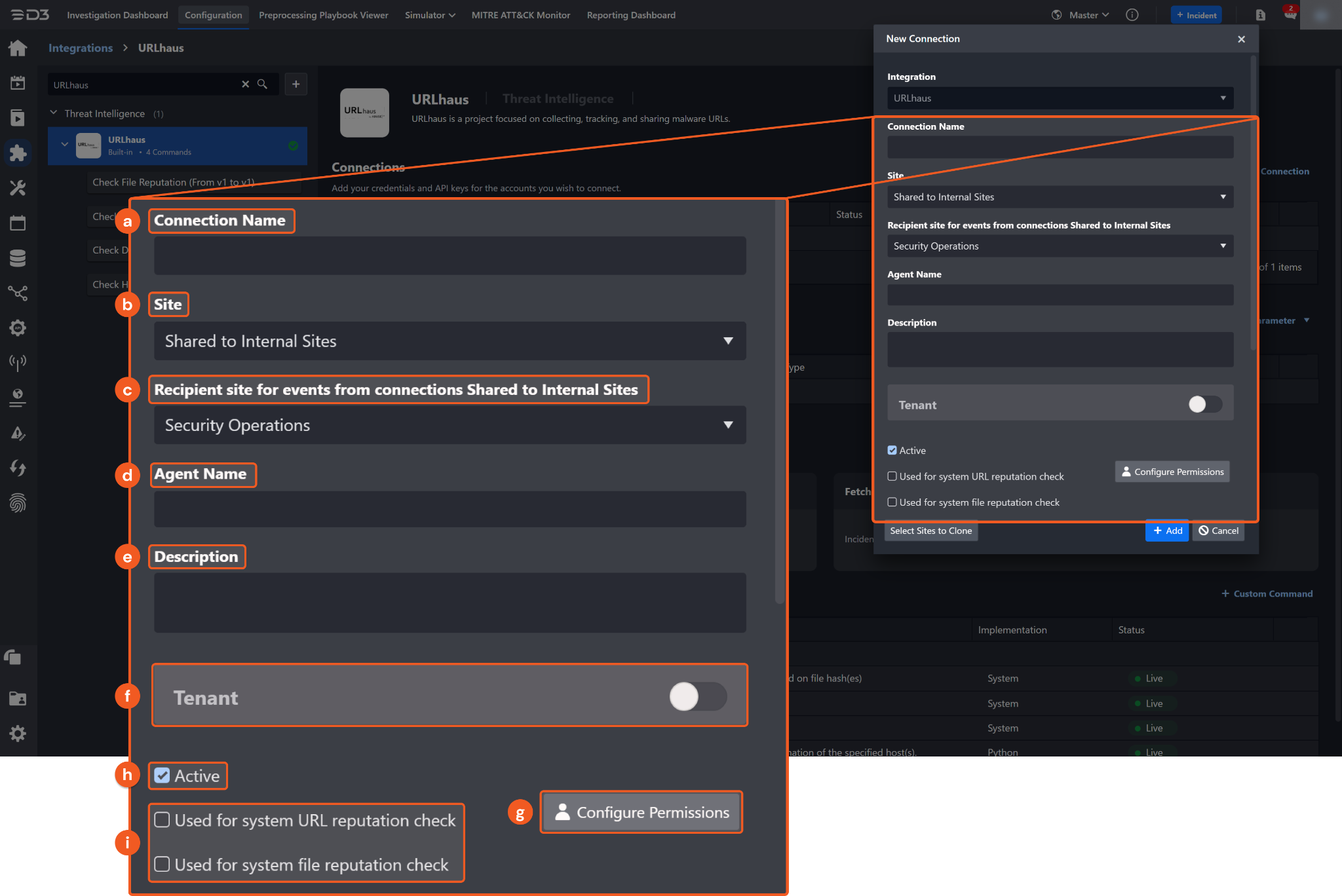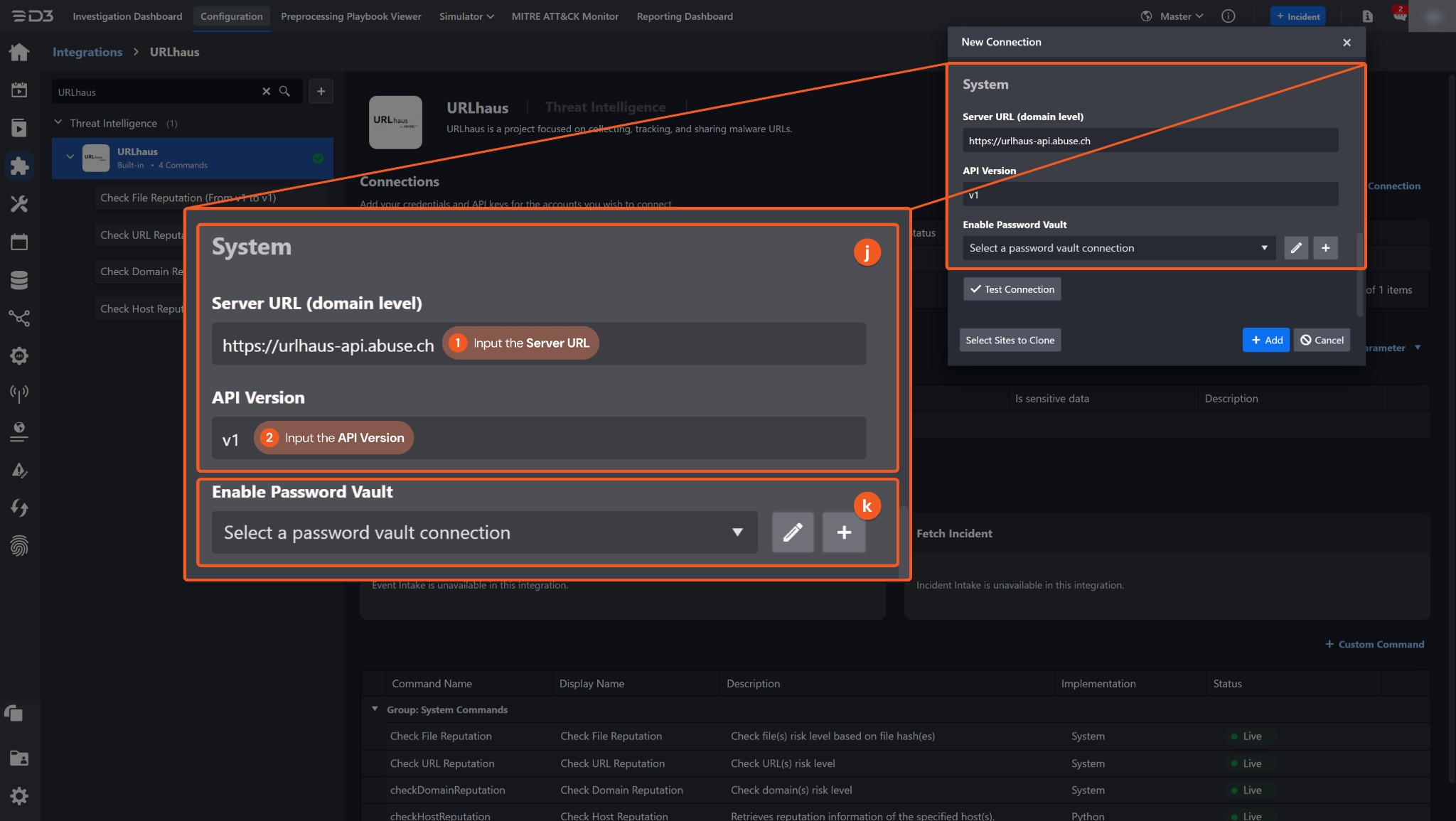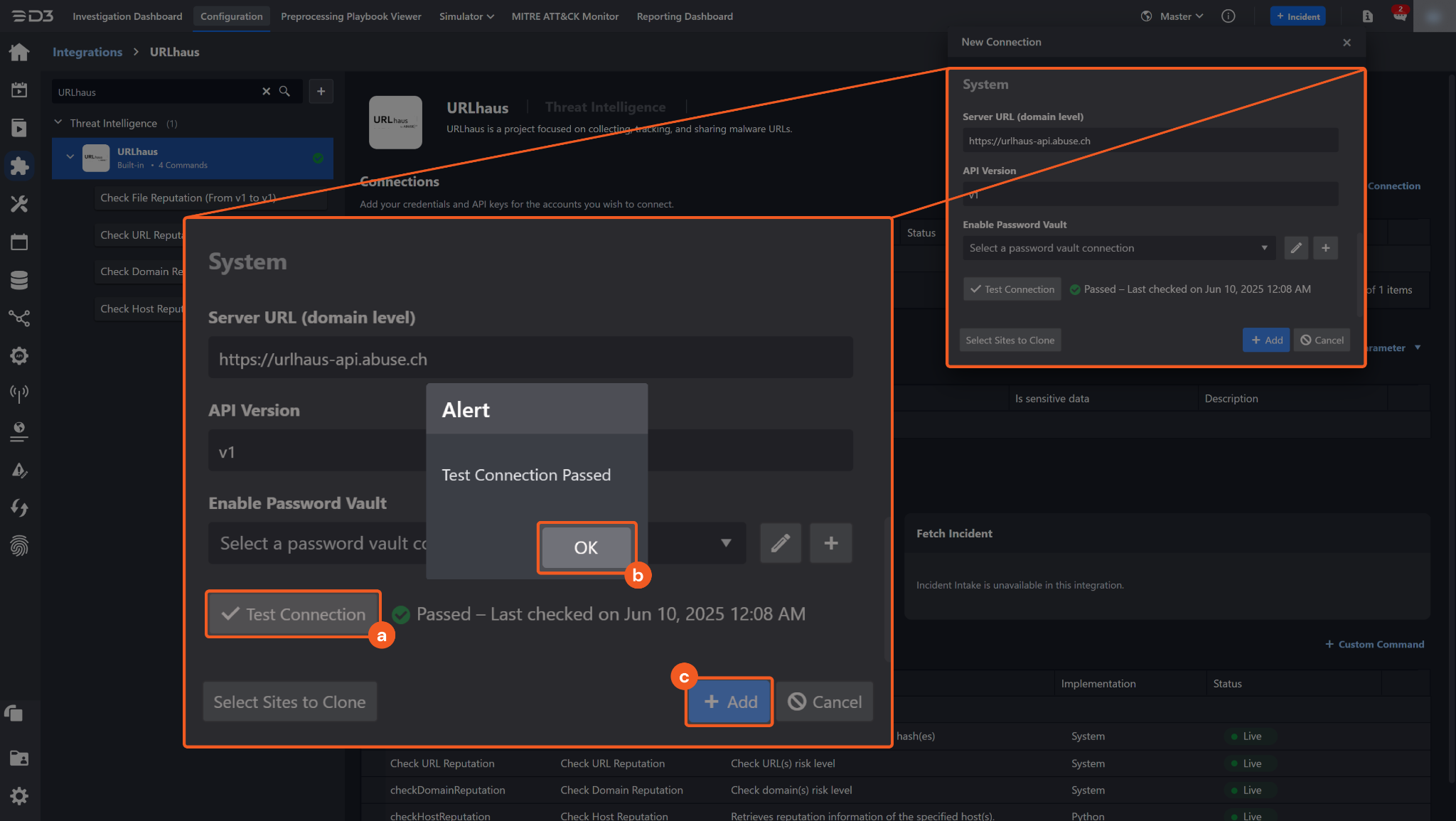URLhaus
LAST UPDATED: JUNE 9, 2025
Overview
URLhaus is an initiative developed by abuse.ch with the objective of facilitating the sharing of malicious URLs used for malware distribution. This integration enables users to access reputation insights on URLs and files, helping them to identify and mitigate potential cybersecurity threats more effectively.
D3 SOAR is providing REST operations to function with URLhaus.
URLhaus is available for use in:
Connection
To connect to URLhaus from D3 SOAR, follow this part to collect the required information below:
Parameter | Description | Example |
Server URL | The server URL of the URLhaus API. | https://urlhaus-api.abuse.ch |
API Version | The version of the API to use for the connection. | v1 |
Configuring D3 SOAR to Work with URLhaus
Log in to D3 SOAR.
Find the URLhaus integration.

Navigate to Configuration on the top header menu.
Click on the Integration icon on the left sidebar.
Type URLhaus in the search box to find the integration, then click it to select it.
Click + Connection, on the right side of the Connections section. A new connection window will appear.
Configure the following fields to create a connection to URLhaus.

Connection Name: The desired name for the connection.
Site: Specifies the site to use the integration connection. Use the drop-down menu to select the site. The Share to Internal Sites option enables all sites defined as internal sites to use the connection. Selecting a specific site will only enable that site to use the connection.
Recipient site for events from connections Shared to Internal Sites: This field is displayed when Share to Internal Sites is selected for the Site field, allowing selection of the internal site for deploying the integration connection.
Agent Name (Optional): Specifies the proxy agent required to build the connection. Use the dropdown menu to select the proxy agent from a list of previously configured proxy agents.
Description (Optional): Add a description for the connection.
Tenant (Optional): When configuring the connection from a master tenant site, users have the option to choose the specific tenant sites to share the connection with. Once this setting is enabled, users can filter and select the desired tenant sites from the dropdowns to share the connection.
Configure User Permissions: Defines which users have access to the connection.
Active: Check the tick box to ensure the connection is available for use.
System Reputation Check: Selecting one or more reputation check tick boxes will run the corresponding check reputation commands under this integration connection to enrich the corresponding artifacts with reputation details.
For example, an integration connection named "ConnectionA" is configured with the "Sandbox" site. All URL artifacts from the "Sandbox" site will undergo a reputation check using the Check URL Reputation command from that integration. The return data output from this command will then be used to update the risk level of artifacts, which may affect the risk level of incoming events.

System: This section contains the parameters defined specifically for the integration. These parameters must be configured to create the integration connection.

1. Input the Server URL of the URLhaus API. The default value is https://urlhaus-api.abuse.ch.
2. Input the API version. The default value is v1.
Enable Password Vault: An optional feature that allows users to take the stored credentials from their own password vault. Refer to the password vault connection guide if needed.
Test the connection.

Click on the Test Connection button to verify credentials and connectivity. A success alert displays Passed with a green checkmark. If the connection fails, review the parameters and retry.
Click OK to close the alert window.
Click Add to create and add the configured connection.
Commands
URLhaus includes the following executable commands for users to set up schedules or create playbook workflows. With the Test Command function, users can execute these commands independently for playbook troubleshooting.
Integration API Note
For more information about the URLhaus API, refer to the URLhaus API reference.
Check Domain Reputation
Retrieves the risk levels of the specified domains.
Input
Input Parameter | Required/Optional | Description | Example |
Domains | Required | The domains for which reputation will be checked. |
JSON
|
Output
To view the sample output data for all commands, refer to this article.
D3-defined Risk Levels and Risk Level Names
The table below lists the possible output risk levels and their corresponding risk level names:
Risk Levels | Risk Level Names |
1 | High |
2 | Medium |
3 | Low |
4 | N/A |
5 | ZeroRisk |
Error Handling
If the Return Data is Partially Successful or Failed, an Error tab will appear in the Test Result window.
The error tab contains the details responded from D3 SOAR or third-party API calls, including Failure Indicator, Status Code, and Message. This can help you locate the root cause of a command failure.
Parts in Error | Description | Example |
Failure Indicator | Indicates the command failure that happened at a specific input and/or API call. | Check Domain Reputation failed. |
Status Code | The response code issued by the third-party API server or the D3 SOAR system that can be used to locate the corresponding error category. For example, if the returned status code is 401, the selected connection is unauthorized to run the command. The user or system support would need to check the permission setting in the URLhaus portal. Refer to the HTTP Status Code Registry for details. | Status Code: 404. |
Message | The raw data or captured key error message from the integration API server about the API request failure. | Message: Domain Not Found. |
Error Sample Data Check Domain Reputation failed. Status Code: 404. Message: Domain Not Found. |
Check File Reputation
Retrieves the risk levels of the specified file hashes.
Input
Input Parameter | Required/Optional | Description | Example |
File Hashes | Required | The file hashes for which reputation will be checked. MD5 and SHA256 hashes are supported. |
JSON
|
Output
To view the sample output data for all commands, refer to this article.
D3-defined Risk Levels and Risk Level Names
The table below lists the possible output risk levels and their corresponding risk level names:
Risk Levels | Risk Level Names |
1 | High |
2 | Medium |
3 | Low |
4 | N/A |
5 | ZeroRisk |
Error Handling
If the Return Data is Partially Successful or Failed, an Error tab will appear in the Test Result window.
The error tab contains the details responded from D3 SOAR or third-party API calls, including Failure Indicator, Status Code, and Message. This can help you locate the root cause of a command failure.
Parts in Error | Description | Example |
Failure Indicator | Indicates the command failure that happened at a specific input and/or API call. | Check File Reputation failed. |
Status Code | The response code issued by the third-party API server or the D3 SOAR system that can be used to locate the corresponding error category. For example, if the returned status code is 401, the selected connection is unauthorized to run the command. The user or system support would need to check the permission setting in the URLhaus portal. Refer to the HTTP Status Code Registry for details. | Status Code: 404. |
Message | The raw data or captured key error message from the integration API server about the API request failure. | Message: File Not Found. |
Error Sample Data Check File Reputation failed. Status Code: 404. Message: File Not Found. |
Check Host Reputation
Retrieves reputation information on the specified hosts.
Input
Input Parameter | Required/Optional | Description | Example |
Hosts | Required | The hosts for which reputation will be checked. Values are case-insensitive and may be IPv4 addresses, hostnames, or domain names. |
JSON
|
Output
To view the sample output data for all commands, refer to this article.
Error Handling
If the Return Data is Partially Successful or Failed, an Error tab will appear in the Test Result window.
The error tab contains the details responded from D3 SOAR or third-party API calls, including Failure Indicator, Status Code, and Message. This can help you locate the root cause of a command failure.
Parts in Error | Description | Example |
Failure Indicator | Indicates the command failure that happened at a specific input and/or API call. | Check Host Reputation failed. |
Status Code | The response code issued by the third-party API server or the D3 SOAR system that can be used to locate the corresponding error category. For example, if the returned status code is 401, the selected connection is unauthorized to run the command. The user or system support would need to check the permission setting in the URLhaus portal. Refer to the HTTP Status Code Registry for details. | Status Code: 404. |
Message | The raw data or captured key error message from the integration API server about the API request failure. | Message: Host Not Found. |
Error Sample Data Check Host Reputation failed. Status Code: 404. Message: Host Not Found. |
Check URL Reputation
Retrieves the risk levels of the specified URLs.
Input
Input Parameter | Required/Optional | Description | Example |
URLs | Required | The URLs for which reputation will be checked. |
JSON
|
Output
To view the sample output data for all commands, refer to this article.
D3-defined Risk Levels and Risk Level Names
The table below lists the possible output risk levels and their corresponding risk level names:
Risk Levels | Risk Level Names |
1 | High |
2 | Medium |
3 | Low |
4 | N/A |
5 | ZeroRisk |
Error Handling
If the Return Data is Partially Successful or Failed, an Error tab will appear in the Test Result window.
The error tab contains the details responded from D3 SOAR or third-party API calls, including Failure Indicator, Status Code, and Message. This can help you locate the root cause of a command failure.
Parts in Error | Description | Example |
Failure Indicator | Indicates the command failure that happened at a specific input and/or API call. | Check URL Reputation failed. |
Status Code | The response code issued by the third-party API server or the D3 SOAR system that can be used to locate the corresponding error category. For example, if the returned status code is 401, the selected connection is unauthorized to run the command. The user or system support would need to check the permission setting in the URLhaus portal. Refer to the HTTP Status Code Registry for details. | Status Code: 404. |
Message | The raw data or captured key error message from the integration API server about the API request failure. | Message: URL Not Found. |
Error Sample Data Check URL Reputation failed. Status Code: 404. Message: URL Not Found. |
Test Connection
Allows users to perform a health check on an integration connection. Users can schedule a periodic health check by selecting Connection Health Check when editing an integration connection.
Input
N/A
Output
Output Type | Description | Return Data Type |
Return Data | Indicates one of the possible command execution states: Successful or Failed. The Failed state can be triggered by any of the following errors:
More details about an error can be viewed in the Error tab. | String |
Error Handling
If the Return Data displays Failed, an Error tab will appear in the Test Result window.
The error tab contains the details responded from D3 SOAR or third-party API calls, including Failure Indicator, Status Code, and Message. This can help locate the root cause of a command failure.
Parts in Error | Description | Example |
Failure Indicator | Indicates the command failure that happened at a specific input and/or API call. | Test Connection failed. Failed to check the connector. |
Status Code | The response code issued by the third-party API server or the D3 SOAR system that can be used to locate the corresponding error category. For example, if the returned status code is 401, the selected connection is unauthorized to run the command. The user or system support would need to check the permission setting in the URLHaus portal. Refer to the HTTP Status Code Registry for details. | Status Code: 400. |
Message | The raw data or captured key error message from the integration API server about the API request failure. | Message: The remote name could not be resolved. |
Error Sample Data Test Connection failed. Failed to check the connector. Status Code: 400. Message: The remote name could not be resolved. |
